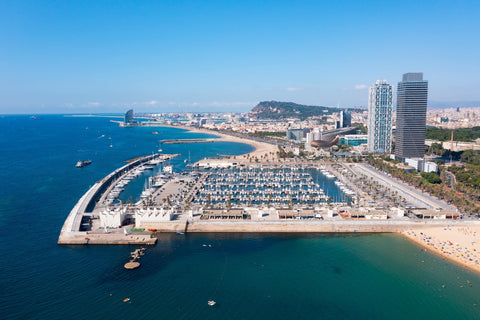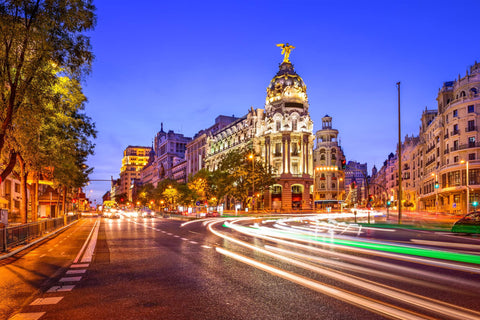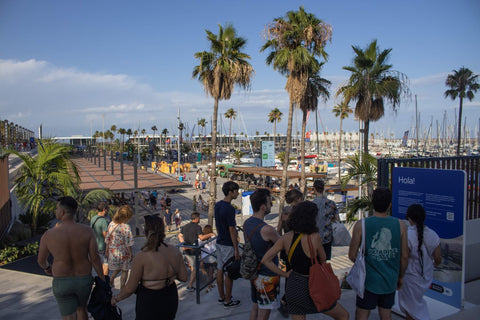Barcelona’s bustling cruise port is one of the busiest in Europe, welcoming travelers from around the globe. To help you kick off your journey smoothly, we’ve put together this guide on preparing for and boarding your next cruise. Whether you’re a first-time cruiser or a seasoned traveler, here’s everything you need to know to navigate the process in Barcelona with ease and confidence.
Pre-Boarding Checklist
On your day of departure, Barcelona’s cruise terminals buzz with activity from as early as 9:00 a.m. To minimize delays and ensure a smooth onboarding process, follow this checklist before you arrive at the port:
1. Travel Documents
Barcelona is part of the Schengen Area, which has specific requirements for travelers depending on their nationality and cruise itinerary.
• For EU/EEA Citizens:
• A valid national ID card or passport.
• Check if your cruise line requires a passport instead of an ID card for certain non-EU ports.
• For Non-EU/EEA Travelers (including UK, USA, Canada, Australia, etc.):
• A valid passport with at least six months’ validity beyond your trip.
• Check if a Schengen visa or other visas are required for the ports on your itinerary.
• Visas and Other Requirements:
• If your cruise will call at countries outside the Schengen Area (e.g., Morocco, Turkey), ensure you have all necessary visas in place.
• If flying into Spain, verify any transit visa requirements if you’re connecting through other European airports.

2. Health and Vaccination Certificates
• Check your cruise line’s COVID-19 protocols and health requirements.
• Some destinations may require specific vaccinations or health certificates. Verify these well in advance.
3. Cruise Documents
• Complete the cruise line’s online check-in, if available.
• Print or save digital copies of your boarding passes, luggage tags, and any relevant travel confirmations.
4. Luggage
• Clearly label your luggage with your name, contact information, and cabin number.
• Pack medications, travel-size toiletries, valuables, and a change of clothes in your carry-on.
Bringing Liquids and Alcohol in Luggage
Liquids
• Adhere to security regulations similar to airlines: containers must be 100 ml (3.4 oz) or smaller, all fitting in one clear, resealable plastic bag (1 liter capacity).
• Larger liquids, such as shampoos and lotions, should go in checked luggage, sealed to prevent leakage.
Alcohol
• Policies vary by cruise line, but most allow one bottle of wine or champagne (typically 750 ml) per adult in carry-on luggage.
• Spirits, beer, or other alcoholic beverages are usually prohibited in carry-on or checked luggage.
• Alcohol purchased at ports or in duty-free shops is often held by the cruise line until the final day of the trip.
• Corkage fees may apply if you wish to consume your own wine or champagne in onboard restaurants.
Always confirm your cruise line’s specific alcohol and liquids policies in advance.

Bringing Food in Luggage
Pre-Packaged Snacks
• Non-perishable, sealed snacks (chips, crackers, granola bars) are generally allowed.
• Keep them in their original, unopened packaging for easy inspection.
Perishable or Homemade Foods
• Typically not permitted due to health and safety regulations.
• Some cruise lines may make exceptions for special dietary needs if you request approval in advance.
Special Dietary Needs
• Inform your cruise line of any dietary restrictions (gluten-free, vegetarian, kosher, etc.) ahead of time.
• Most modern ships can accommodate a wide variety of dietary requirements.
Food for Infants and Toddlers
• Baby formula, milk, and baby food are generally allowed, but bring only what you need for the duration of the cruise.
Bringing Medical Equipment Onboard
Oxygen Tanks and Respiratory Equipment
• Notify your cruise line at least 30 days in advance if you plan to bring oxygen tanks or portable oxygen concentrators.
• Bring enough supplies for the entire trip, plus some extra for emergencies.
Wheelchairs and Mobility Scooters
• You may bring your own wheelchair or scooter if it fits through standard cabin doors (typically 58–69 cm wide).
• Scooters must be battery-operated (gel or dry cell batteries preferred) and stored safely in your cabin.
• Inform the cruise line in advance for accessible cabin arrangements or boarding assistance.
Other Medical Equipment
• CPAP machines, dialysis equipment, nebulizers, etc. are permitted.
• Pack enough consumables (e.g., distilled water for CPAP machines) for the entire journey.
• Always carry vital medical equipment in your carry-on.
Service Animals
• Service animals are generally allowed but require advance notification and proper documentation.
• Designated relief areas vary by cruise line and ship.

Transportation to the Cruise Port
Barcelona’s main cruise terminals (Terminals A, B, C, D, E at the Adossat Quay, plus the World Trade Center terminals) are located close to the city center.
• By Taxi or Rideshare: Taxis are plentiful and reliable. There are also rideshare options like Uber or Cabify in Barcelona.
• By Public Transit: You can take the metro to Drassanes station (L3 Green Line) or Paral·lel station (L2 Purple Line or L3 Green Line) and then connect via bus or taxi to the cruise terminals.
• Parking: Several parking facilities near the port offer short-term or long-term parking options.
Arrive at the terminal during your assigned boarding window to reduce wait times.
Arrival at the Port of Barcelona
Navigating the Terminals
• Follow the signs or ask staff for directions to baggage check-in and the check-in counters.
• The port offers accessible pathways and ramps for passengers with reduced mobility.
Baggage Handling
• Most cruise lines allow baggage drop-off starting around 9:30 or 10:00 a.m.
• Label your suitcases with your ship’s name and cabin number.
• Retain passports, medications, and valuables in your carry-on.
Check-In and Passenger Screening
• Proceed to the check-in counter to verify your travel documents.
• After check-in, you’ll go through security screening. Have your boarding pass and ID ready.
Customs and Immigration
• For cruises visiting non-EU countries, you may go through exit customs and passport control before boarding.
• Follow any additional instructions from port authorities and cruise line staff.
Short-Term Baggage Storage
If you wish to explore Barcelona before boarding and need a place to store your luggage, check whether your cruise line or local providers offer short-term storage. Some passenger-focused services allow day storage (but not overnight) near the terminal.
Disembarking in Barcelona
Upon your return, or if Barcelona is your final stop:
• You may need to pass through immigration (particularly if arriving from a non-EU port).
• Collect your luggage in the designated baggage claim area.

FAQ for Boarding a Cruise at the Port of Barcelona
1. Where can I get information on attractions, hotels, and dining in Barcelona?
Visit Turisme de Barcelona or the Barcelona Tourist Office for details on sights, tours, and accommodations.
2. Which cruise lines operate out of Barcelona?
Major lines include MSC Cruises, Royal Caribbean, Norwegian Cruise Line, Costa Cruises, and Carnival, among others. Check each line’s website for specific routes and schedules.
3. Who do I contact for lost baggage or items left on the ship?
Contact your cruise line’s customer service directly. The Port of Barcelona does not handle lost baggage.
4. Is there a lost and found office?
If you lost an item in or around the cruise terminal, contact the Port of Barcelona authorities. If the item was lost onboard, contact your cruise line.
5. How do I arrange food or package deliveries to the ship?
Coordinate with your cruise line directly. Port employees generally cannot facilitate deliveries.
6. Can I bring liquids and alcohol on board?
Most cruise lines follow similar airline-style limits for liquids in carry-on bags. Check the line’s policy for bringing wine or champagne onboard. Spirits and beer are typically prohibited.
7. Can I bring food on board?
Pre-packaged, non-perishable snacks are usually allowed in their original packaging. Perishable foods are restricted. Notify your cruise line in advance if you have special dietary needs.
8. Can I bring medical equipment like wheelchairs or oxygen tanks?
Yes, with advance notice to your cruise line. Equipment must meet size and safety standards.
9. What services are available for accessibility?
Barcelona’s cruise terminals adhere to European accessibility regulations. Mobility scooters and wheelchairs can be rented through local providers or your cruise line’s recommended partners. Service animals are permitted with proper documentation.
10. Is there luggage storage at the terminal?
Short-term luggage storage may be available through third-party providers. Contact your cruise line or port services for details.
11. What are the steps for check-in and boarding?
1. Arrival: Follow signage or ask staff for directions.
2. Baggage Drop-Off: Label your bags and keep important items with you.
3. Check-In: Show your travel and identification documents.
4. Security Screening: Have your boarding pass ready.
5. Customs/Passport Control (if applicable): For non-EU itineraries.
12. What happens when I disembark in Barcelona?
You’ll collect your baggage and may go through passport control if arriving from outside the Schengen Area.
13. Who can I contact for additional assistance or special accommodations?
• Your cruise line’s guest services or accessibility desk.
• The Port of Barcelona’s information services.
14. How can I get to the cruise port?
• Taxi/Rideshare: Widely available.
• Metro or Bus: Drassanes (L3) or Paral·lel (L2, L3) stations, then a short taxi or shuttle to the terminal.
• Car: Ample parking options nearby.
Rent a Mobility Scooter for Your Barcelona Cruise
At Scooter Town, we offer quality mobility rental products at affordable prices. Whether you need a mobility scooter (ECV), powerchair, or wheelchair, we’ve got you covered. We deliver directly to your hotel or the cruise terminal.
Contact us at +1-800-329-9122 to book your scooter rental today.
Enjoy your cruise from Barcelona with peace of mind, knowing you’ve taken care of all the details in advance. ¡Buen viaje!




